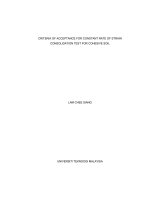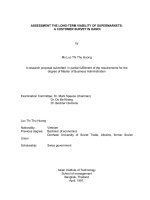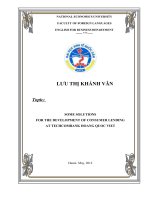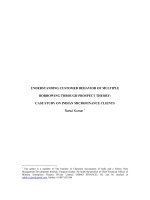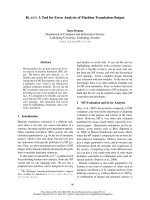understanding consumer behavior for washing machine of sanyo home applicance asia corporation
Bạn đang xem bản rút gọn của tài liệu. Xem và tải ngay bản đầy đủ của tài liệu tại đây (344 KB, 67 trang )
MINISTRY OF EDUCATION AND TRAINING
NATIONAL ECONOMICS UNIVERSITY
NEU BUSINESS SCHOOL
DO THI MINH NGUYET
UNDERSTANDING CONSUMER BEHAVIOR
FOR WASHING MACHINE OF SANYO HOME
APPLICANCE ASIA CORPORATION
MASTER OF BUSINESS ADMINISTRATION THESIS
60.34.05
SUPERVISOR: DR. TRAN VAN HUNG
HANOI - 2010
ACKNOWLEDGEMENT
I am grateful to a number of people who have helped me in the writing
of this research. Firstly, I would like to express my gratitude to Dr Tran Van
Hung, who guided me all their heart during the process I wrote the
assignment. Furthermore, I would also like to thank the lecturers who taught
me other subjects in BSNEU and created good conditions for me to study and
write this assignment.
I would like to thank Mr Hoang Tat Thang working at Pico Plaza; Mrs
Nguyen Minh Ngoc is working at Sai Gon Nguyen Kim Plaza , Where I
collect informations, interview and apply qualitative and quantitative methods
to understand more about selling and management systems in trade centers in
Viet Nam.
I hope that this graduation assignment will appeal to all of those who
helped me make it.
Do Thi Minh Nguyet
1
ABBREVIATION
CoA: Cojoint Analysis
CuA: Cluster Analysis
WM: Washing machine
HCMC: Ho Chi Minh City
MBA: Master of Bussiness Administration
PLC: Product Life cycle
PR: Public relation
VND: Vietnamese Dong
SWOT: stands for strengths, weaknesses, opportunities, and threats.
SHA: Sanyo Home Appliances Asia Corporation
MM: Marketing Mix
2
LIST OF TABLES
LIST OF FIGURES
Figure 1: The number of families are using the washing machine in Vietnam
(From 2002 to 2008) Error: Reference source not found
Figure 2: Result of questionair for customers at trade sites Error: Reference
source not found
Figure 3: The newspapers and magazines which the consumers often read 59
3
TABLE OF CONTENTS
EXECUTIVE SUMMARY
After years of market presence in Vietnam, Sanyo washing machines
have become a trusted brand name and familiar in Vietnameses life
(especially people in urban areas). Under the influence of market economy,
globalization trends have great impact on the operation of manufacturing
household goods of Sanyo factory in Vietnam, particularly affecting the
consumption of washing machines of Sanyo Home Appliances Asia
Corporation. Under this context, the overall objective of the study is ti analyze
customer behavior for washing machine of Sanyo Home Appliances Asia
Corporation, in order to apply maketting mix understanding and other theories
of consumer behavior for giving out some best and suitable proposals for
Sanyo Home Appliances Asia Corporation to expand the washing machine
market share in the next period in Vietnam.
The data is mainly used as inputs for this thesis are sample
questionaires, which gave to consumer at Saigon Nguyen Kim plaza and Pico
plaza, make interview with sale managers, data on GSO (General statistic),
Sanyo website and its competitors.
Base on the theories of consumer behavior as: Maketting mix and
SWOT analysis and other theories to describe and analyze consumption
patterns, attribute preference, impact factors and market segmentation of
Sanyo washing machine in Vietnamese maket. Following this result, the study
obtains findings as:
4
From 1997 to late months of 2006 Sanyo Home Appliances Asia
Corporation doing business very well, but from the early months in 2007 to
now, the washing machine market share of SHA is decreasing in Vietnam, in
2006 is 40% but in 2007 decreasing at 38% and 2008 is at 35%
(Although It
was voted top brand in 2009). Only from year 2006 to 2008 the washing
machine market share of SHA decrease 5%, this is issue the board of directors
of Sanyo Home Appliances Asia Corporation are very worried and
embarrassing to find correct steps for SHA.
SHA leadership has too much japaneses, only 6 employees in charge of
the washing machine sector - lack of concentration of market research and
launching sales campaigns, the strategies to attract customers from
competitors. Beside it, SHA is depending too much on the four units – level
one agents: 266 agents for a Trade and Service Company, Huong Thuy
Company Ltd., the era of the Pacific Trade and Service Company, Trade and
Thanh Nha Service Company.
After reviewing the spending habits of Vietnamese, washing machine
features available on the Vietnamese market, which is made by competitors,
in order to find its strengths and weaknesses based on the elements of the
Marketing mix theory ( 4P) shows: Sanyo are not only afraid of these kinds of
competitors as: LG vina, Samsung, Hitachi…., but also the SHA need to pay
attention to the products imitated the label such as: Sankyo (imitated from
Logo of Sanyo) Sonica (imitated from Sony). It has bad influences to SHA
because it will be misunderstood by the people have the low knowledge.
The obtained sides
- About scale of market: nowadays it has been present almost the cities
and areas of Vietnam such as: Hanoi, Hai Phong, Danang, Nam Dinh, Can
Tho, Binh Duong….besides, the warranty and maintenance centres also have
5
been expanded throughout Vietnam, satisfy immediately whenever the
customers’ machines have problem.
- About market share: In Vietnam, Sanyo has occupied over 40% the
market share in 2006 for the home appliances washing machine field
(
14
source from internal report of SHA). Having the good result due to the a lot
of factors, in there, the quality of product has been believed by the customers,
the price is acceptable, the after sale services are good (warranty and
maintenance).
The limited sides
- About market share: Only from year 2006 to 2008 the washing
machine market share of SHA decrease 5%. For some reasons may be: Not
establish the Marketing department separated yet (The Marketing activities
depend quite on 4 companies); Not yet investing so much for advertising and
financing for the big programes; Staff level; The price is not suitable…
Recommendations
In the period 2008-2010 SHA needs to have suitable policies to expand
Vietnam market as follows:
+ Establishing the Marketing department immediately and organizing
the personnel in there suitably and the most effective.
+ Decreasing the dependence on 4 companies by increasing the agency
system, warranty and maintenance centres over Vietnam’ domain, especially
is the big cities.
+ Increasing the product advertisements suitably on the mass media
such as: newspaper, magazine of consumer, radio, TV. However, the expense
is very expensive but the effect is very big.
6
+ Need to invest finance for big programmes such as children
programmes, educational programmes, entertainment programmes
(especially housework programmes on television).
+ Adjusting or changing the personnel for Sale department where not
having the professional staff about business knowledge.
+ Changing the salary structure suitably, should have favour policies
with staff dedicate so much for company.
+ In addition, the board of directors should care for circumstances and
mentality of staff, visit them when they are sick or have problem about their
mind.
7
ABSTRACT
This research is going to see the consumer behavior for washing machine
of Sanyo Home Applicances Asia Corporation, that helps in identifying the
weak points and also reflects the positive aspect of business selling.
In order to give out the suitable selling methods for Sanyo Home
Appliances Asia Corporation, the research is going to carry out following
tasks:
. Analyzing the current situation of the washing machine market share of
Sanyo Home Appliances Asia Corporation
.To find out the factors affected to the washing machine market share of
Sanyo Home Appliances Asia Corporation.
.To find out the advantages and disadvantages of Sanyo Home
Appliances Asia Corporation.
.To understand customer behaviours to give marketing suggestions and
recommendations to increase the washing machine market-share of SHA
Corporation.
8
CHAPTER 1: INTRODUCTION
1.1. Rationale:
Vietnam is a developing country, with the population nearly 87 million.
Vietnam has a thousand-year history, with an originally traditional culture,
variety of relics. The culture, society, politics are always stable. Especially,
after 11-9 event Vietnam was considered one of the safest countries in the
area and over the world. In recent years, along with the development of
economy, the incomes of Vietnameses are increasing day by day. So their
demands about home appliances are also developing. The people want to save
their time for washing the clothes and the dishes to relax and entertain. So the
washing machine has been becoming necessary and popular in almost urban
families, especially, washing machine is selling well in the big cities such as:
Hanoi, Saigon, Haiphong, Danang…,for that important reason, the Sanyo
Electronic Osaka Japan invested in Vietnam. The project was executed in
1995, including three big share-holders of Corp., are Sanyo Electronic Osaka
Japan, Sumitomo Corporation and Sanyo Trading Corporation with invested
capital is USD$ 75 millions
1
, the operation time of the project is 30 years. It
run on 26 July 1997 with named Sanyo Home Appliances Asia Corporation
(SHA).
1.2. RESEARCH PROBLEM
Vietnam is the nation has got the rate of young population, 60% in the
age of working (according to the statistic in 2007). This is the cheap and
plentiful labour source for the foreign investors in Vietnam but this is also
difficult problem for Vietnam’s government to resolve the employment.
The Vietnameses are very curious and like the new things. When
seeing the neighbour has got some new things so they also want their house
9
have got those. Specially, the Vietnamese like the foreign products so much.
The foreign companies will be successful if knowing this disadvantage of
Vietnamese.
Sanyo is not only famous Corporation of Japan but also well-known
through the world about electronic products such as: refrigerator, microware,
cooking, washing machine…
Sanyo label has been in Vietnam a long time before 1975 but until 1997
it has just a factory located in Bien Hoa- Dong Nai. This factory is specialized
in producing and assembling the washing machine and refrigerator with
named Sanyo Home Appliances Asia Corporation (SHA). When not having
the factory in Vietnam, the products and alternative components named Sanyo
are imported from Japan or Thailand (Sanyo label but made in Thailand).
From 1997 to late months of 2006 Sanyo Home Appliances Asia Corporation
doing business very well in Vietnam and exporting to other countries. At this
time, the products of SHA has been 30 countries in the world, but from the
early months in 2007 to now, the washing machine market share of SHA is
decreasing in Vietnam, in 2006 is 40% but in 2007 decreasing at 38% and
2008 is at 35%
(Although It was voted top brand in 2009). Only from year
2006 to 2008 the washing machine market share of SHA decrease 5%, this is
issue the board of directors of Sanyo Home Appliances Asia Corporation are
very worried and embarrassing to find correct steps for SHA at the present
and the future.
While studying Business and management at the National Economic
University I have obtained the fixed knowledge about Marketing such as:
research and develop the market, analyse and evaluate the information of the
market and other competitors…etc.
10
As a result, I chose this topic “Understanding consumer behaviour for
washing machine of Sanyo Home Applicances Asia Corporation”. I want to
apply my knowledge about Marketing studied at the National Economic
University to give out some best and suitable proposals for Sanyo Home
Appliances Asia Corporation to expand the washing machine market share in
the next period in Vietnam.
1.3. RESEARCH OBJECTIVE:
The aim of this research is the researcher will analysis the current situation of
Sanyo Home Appliances Asia Corporation and give out some marketing
suggestions and recommendations of SHA in the next period.
The main objective:
Understanding consumer behaviour for washing machine of Sanyo Home
Applicances Asia Corporation.
The sub- objectives:
1. To analyze the current situation of the washing machine market share of
Sanyo Home Appliances Asia Corporation
2. To find out the factors affected to the washing machine market share of
Sanyo Home Appliances Asia Corporation.
3. To find out the advantages and disadvantages of Sanyo Home
Appliances Asia Corporation.
1.4. Research questions
Questionaires for:
11
- Customers
- Sale managers
- Sale staffs
What is the pattern of washing machine consumption in Viet Nam?
What are the factors influencing customer behavior of washing
machine in Ha noi and Viet Nam?
How is marketing activities of SHA?
…
1.5. RESEARCH SCOPE
Due to the limit of time and collected literatures, so the researcher only
focus on researching customer behavior of Sanyo washing machine to give
out the most suitable Marketing recommendation for SHA making to increase
the market share for washing machine in the next period in Vietnam (2010-
2011).
1.6. RESEARCH LIMITATIONS
Because of time limit to meet customers at the supper markets, I just
chose sample size are 100 customers and give out some recommendations
(not solutions or strategies) to expand market share for washing machine in
the next period in Vietnam.
CHAPTER 2: THEORETICAL BACKGROUND OF
CUSTOMERR BEHAVIOR
12
Consumer behaviour is the study of when, why, how, and where people
do or do not buy product. It blends elements from psychology, sociology,
social anthropology and economics. It attempts to understand the buyer
decision making process, both individually and in groups. It studies
characteristics of individual consumers such as demographics and behavioural
variables in an attempt to understand people's wants. It also tries to assess
influences on the consumer from groups such as family, friends, reference
groups, and society in general.
Customer behaviour study is based on consumer buying behaviour,
with the customer playing the three distinct roles of user, payer and buyer.
Relationship marketing is an influential asset for customer behaviour analysis
as it has a keen interest in the re-discovery of the true meaning of marketing
through the re-affirmation of the importance of the customer or buyer. A
greater importance is also placed on consumer retention, customer
relationship management, personalisation, customisation and one-to-one
marketing. Social functions can be categorized into social choice and welfare
functions.
Each method for vote counting is assumed as a social function but if
Arrow’s possibility theorem is used for a social function, social welfare
function is achieved. Some specifications of the social functions are
decisiveness, neutrality, anonymity, monotonicity, unanimity, homogeneity
and weak and strong Pareto optimality. No social choice function meets these
requirements in an ordinal scale simultaneously. The most important
characteristic of a social function is identification of the interactive effect of
alternatives and creating a logical relation with the ranks. Marketing provides
services in order to satisfy customers. With that in mind, the productive
13
system is considered from its beginning at the production level, to the end of
the cycle, the consumer (Kioumarsi et al., 2009).
Belch and Belch define consumer behaviour as 'the process and
activities people engage in when searching for, selecting, purchasing, using,
evaluating, and disposing of products and services so as to satisfy their needs
and desires'.'
(Definition from )
Definition of Buying Behavior:
Buying Behavior is the decision processes and acts of people involved
in buying and using products.
We have to find:
+ Why consumers make the purchases that they make?
+ What factors influence consumer purchases?
+ The changing factors in our society.
Consumer Buying Behavior refers to the buying behavior of the
ultimate consumer. A firm needs to analyze buying behavior for:
Buyers reactions to a firms marketing strategy has a great impact on the
firms success.
The marketing concept stresses that a firm should create a Marketing
Mix (MM) that satisfies (gives utility to) customers, therefore need to analyze
the what, where, when and how consumers buy.
Marketers can better predict how consumers will respond to marketing
strategies.
Types of Consumer Buying Behavior
14
Types of consumer buying behavior are determined by:
+ Level of Involvement in purchase decision. Importance and intensity
of interest in a product in a particular situation.
+ Buyers level of involvement determines why he (she) is motivated to
seek information about a certain products and brands but virtually ignores
others.
+ High involvement purchases: Honda Motorbike, high priced goods,
products visible to others, and the higher the risk the higher the involvement.
Types of risk:
Personal risk
Social risk
Economic risk
The four type of consumer buying behavior are:
Routine Behavior buying: low involvement frequently purchased low
cost items; need very little search and decision effort; purchased almost
automatically. Examples include soft drinks, foods etc.
Limited Decision Making buying product occasionally. When you need
to obtain information about unfamiliar brand in a familiar product category,
perhaps. Requires a moderate amount of time for information gathering.
Examples: Clothes know product class but not the brand.
Extensive Decision Making (Complex high involvement, unfamiliar,
expensive or infrequently bought products). High degree of economic,
performance and psychological risk. Examples: cars, homes, computers,
education. Spend alot of time seeking information and deciding. Information
15
from the companies; friends and relatives, store personnel etc. Go through all six
stages of the buying process.
Impulse buying, no conscious planning: The purchase of the same
product does not always elicit the same Buying Behavior. Product can shift
from one category to the next.
For example:
Going out for dinner for one person may be extensive decision making
(for someone that does not go out often at all), but limited decision making
for someone else. The reason for the dinner, whether it is an anniversary
celebration, or a meal with a couple of friends will also determine the extent
of the decision making.
Stages of the Consumer Buying Process:
Consumer buying behavior refers to the buying behavior of final
consumers (individual and housholds) who buy good and services for
personal consumption.
Six Stages to the Consumer Buying Decision Process (For complex
decisions). Actual purchasing is only one stage of the process. Not all
decision processes lead to a purchase. All consumer decisions do not always
include all 6 stages.
The 6 stages are:
Problem Recognition (awareness of need): difference between the
desired state and the actual condition. Deficit in assortment of products.
Example: Hunger-Food, Hunger stimulates your need to eat.
Information search (Internal search, memory): External search if you
need more information.
16
Example: Customer can find from public sources, friends or after
comparison shopping.
Evaluation of Alternatives need to establish criteria for evaluation,
features the buyer wants or does not want. Rank/weight alternatives or resume
search.
If not satisfied with your choice then return to the search phase. Can
you think of another restaurant? Look in the yellow pages etc. Information
from different sources may be treated differently. Marketers try to influence
by "framing" alternatives.
Purchase decision: Choose buying alternative, includes product,
package, store, method of purchase etc.
Purchase: May differ from decision, time lapse between 4 & 5, product
availability.
Impressions after purchase: Satisfaction or Dissatisfaction. Cognitive
Dissonance, have you made the right decision. This can be reduced by
warranties, after sales communication.
Therefore, consumer behavior research that is looking for answers to
question: “ How do consumers respond to the marketing effort the company
might use?”, From that, we can offer solutions to access and attract customer.
2.1 Factors influent customer behaviors
Culture: culture is intimately relates to consumer behavior of individuals
and social organizations:
Culture is affecting consumer behavior, to the purchase decision of each
person. Thus, consumer behavior was viewed as a study of the characteristics
of consumer, demographic, psychiatry and the transformation of human
needs.
17
In addition, it is also used to assess the influence of a group of people
as family, friends and society to an individual. Since all aspects of consumer
behavior are cultural elements covered, so the marketing people need to
identify and understand these factors and its impact on global marketing to
achieve success in business.
The relationship between culture and consumer behavior:
Cultural barriers for market development were apparent. To overcome
this barrier requires manufacturers and dealers must "always understood"
local culture and cultural impact of her decision to purchase. In a range of
social behavior of individual consumers will express their own personality
and to build social relationships under the guidance of cultural factors. I just
take for example through Hofsted index measurement in multi-cultural
country.
In Indonesia, some people inherit a legacy of Malay but important
change has been more than 300 different cultures in the territory. Cultural
differences are rooted in conflicts between nations, cultures and beliefs that
produce different consumer behavior. One of the interesting things that the
Indonesians are very polite and always say the word "Yes" in answer although
sometimes the answer is not really accurate. They say that the word "No" will
demonstrate impolite, disrespectful people face.
If not understand what little communication there, how to do business,
people can understand and sell to people here. If we do not understand the
culture of Indonesia, did not know about the behavior, human Indonesia, we
can not provide them with products and services.
Culture is a shared experience includes acts was to experience and
directly influence the decision of each individual in society. The consumer
becomes an active social process rooted in cultural factors. Culture affects the
18
choice of consumer products and also affect the beliefs and attitudes of
individuals.
Also, marketing people not only understand customer behavior, change the
behavior of each individual that we need to identify different aspects of
environmental change, competition…
To succeed in the competitive market, we must understand what
competition brings to consumers and their strategies for us to try to respond
promptly. That is indeed not easy. We deeply understand consumer behavior,
expectations and their desires so that we can develop new goods and services
with specific strategies on the markets in the world .
Social factor:
Social class is an open group of individuals who have similar social rank.
US is not a classless society. US criteria; occupation, education, income,
wealth, race, ethnic groups and possessions.
Social class influences many aspects of our lives. upper middle class
Americans prefer luxury cars Mercedes.
+ Upper Americans class (3%) inherited wealth, aristocratic names.
+ Lower-upper class (1.2%) newer social elite, from current professionals
and corporate elite.
+ Upper-middle class (12.5%) ollege graduates, managers and
professionals
+ Middle Americans-middle class (2%) average pay white collar workers
and blue collar friends
+ Working class (38%) average pay blue collar workers
+ Lower Americans-lower class (9%) working, not on welfare
19
+ Lower-lower class (7%) on welfare
Social class determines to some extent, the types, quality, quantity of
products that a person buys or uses.
Lower class people tend to stay close to home when shopping, do not
engage in much prepurchase information gathering.
Stores project definite class images.
Family, reference groups and social classes are all social influences on
consumer behavior. All operate within a larger culture
Family factor: Family consists of different entinities, that have different
age and possition in that family: the choice of products is influenced by
spending of houshold, savings, assets, debts. Family is the most basic group a
person belongs to. Marketers must understand:
+ That many family decisions are made by the family unit.
+ Consumer behavior starts in the family unit.
+ Family roles and preferences are the model for children's future family.
+ Family buying decisions are a mixture of family interactions and
individual decision making.
+ Family acts an interpreter of social and cultural values for the
individual.
The Family life cycle: families go through stages, each stage creates
different consumer demands:
+ Bachelor stage
+ Newly married, young, no children me
+ Youngest child under 6
20
+ Youngest child 6 or over
+ Older married couples with dependant children
+ Older married couples with no children living with them, head in labor
force
+ Older married couples, no children living at home, head retired
+ Solitary survivor, in labor force
+ Solitary survivor, retired
+ Modernized life cycle includes divorced and no children.
Besides the factors mentioned above, there are a number of other
factors directly influence purchasing decisions as well as customer behavior,
such as economic factors, business factors, personal factors
2.2 Consumer choice theory
2.2.1 Buyer decision processes
Buyer decision processes are the decision making processes undertaken
by consumers in regard to a potential market transaction before, during, and
after the purchase of a product or service.
General, decision making is the cognitive process of selecting a course
of action from among multiple alternatives. Common examples include
shopping and deciding what to eat. Decision making is said to be a
psychological construct. This means that although we can never "see" a
decision, we can infer from observable behaviour that a decision has been
made. Therefore we conclude that a psychological event that we call
"decision making" has occurred. It is a construction that imputes commitment
to action. That is, based on observable actions, we assume that people have
made a commitment to effect the action.
21
In general there are three ways of analysing consumer buying decisions.
They are:
Economic models - These models are largely quantitative and are based
on the assumptions of rationality and near perfect knowledge. The consumer
is seen to maximize their utility. See consumer theory. Game theory can also
be used in some circumstances.
Psychological models - These models concentrate on psychological and
cognitive processes such as motivation and need recognition. They are
qualitative rather than quantitative and build on sociological factors like
cultural influences and family influences.
Consumer behaviour models - These are practical models used by
marketers. They typically blend both economic and psychological models.
Nobel laureate Herbert Simon sees economic decision making as a vain
attempt to be rational. He claims (in 1947 and 1957) that if a complete
analysis is to be done, a decision will be immensely complex. He also says
that peoples' information processing ability is very limited. The assumption of
a perfectly rational economic actor is unrealistic. Often we are influenced by
emotional and non-rational considerations. When we try to be rational we are
at best only partially successful.
Buyer decision processes are the decision making processes undertaken
by consumers in regard to a potential market transaction before, during, and
after the purchase of a product or service.
(Definition from )
22
2.2.2 Aplication: Cojoint Analysis (CoA)
CoA definition: is a popular marketing research technique that
marketers use to determine what features a new product should have and how
it should be priced. Conjoint analysis became popular because it was a far less
expensive and more flexible way to address these issues than concept testing.
When faced with a critical product or pricing decision, conjoint
analysis can help and Conjoint is a powerful advanced research technique that
predicts how the market will respond to product or pricing changes by
understanding the trade-offs that customers make during the decision-making
process. The technique can be used to answer the all-important question: what
value does the market place on products or services and their features?
Conjoint analysis allows you to understand your customers’ underlying
value systems and build a market model based on those values. The model
allows you to test the potential impact of product improvements and new
products on market demand. The resulting insights give you a clear
competitive edge.
Conjoint analysis helps answer vital product development and pricing
questions, such as:
+ What combination of features should a product or service offer?
Which are the most critical features, and which are less important?
+ How does price impact demand for the product or service?
+ How well will a new product or service compete in the market?
+ Which strategies will maximize market preference across your product
portfolio?
23
+ Which strategies will minimize cannibalization of existing offerings,
especially premium or higher margin products or services?
+ How vulnerable are you to competitive response?
Steps in developing a conjoint Analysis:
1. Choose product attributes, for example, appearance, size, or price
2. Choose the values or options for each attribute. For example, for the
attribute of size, one may choose the levels of 5”, 10”, or 20”. The
higher the number of options used for each attribute, the more
burden that is placed on the respondents
3. Define products as a combination of attribute options. The set of
combinations of attributes that will be a subset of the possible
universe of products.
4. Choose the form in which the combinations of attributes are to be
presented to the respondents. Options include verbal presentation,
paragraph description, and pictorial presentation.
5. Decide how responses will be aggregated. There are three choices –
use individual responses, pool all responses into a single utinity
function, or define segments of respondents who have similar
preferences.
6. Select the technique to be used to analyze the collected data. The
part worth model is one of the simple models used to express the
utilities of the various attributes. There also are vector (linear)
models and ideal-point (quadralic) model.
24

